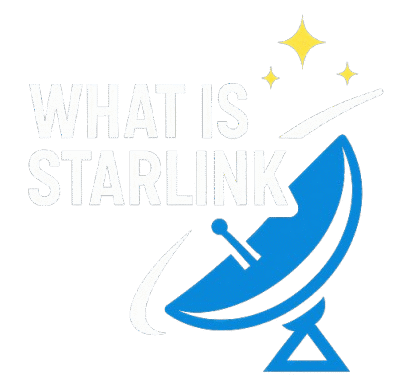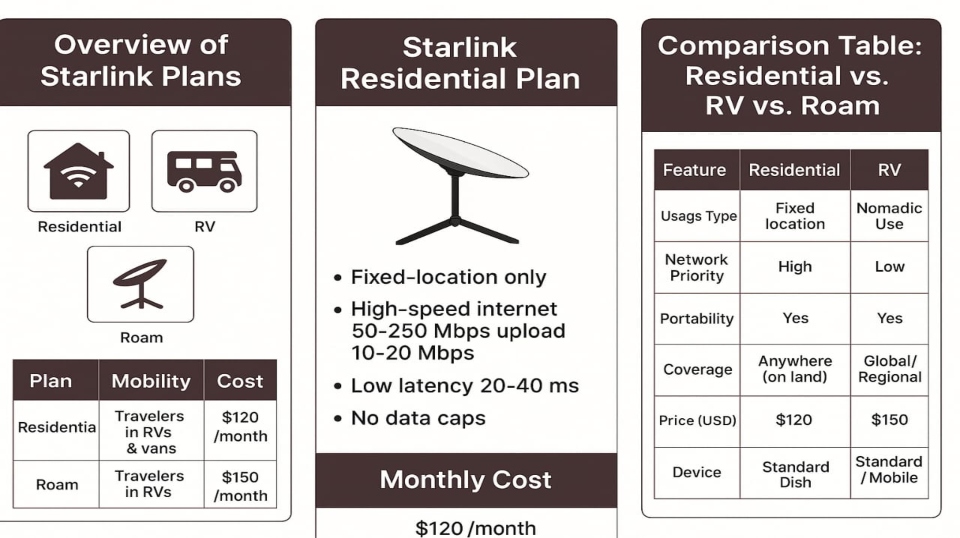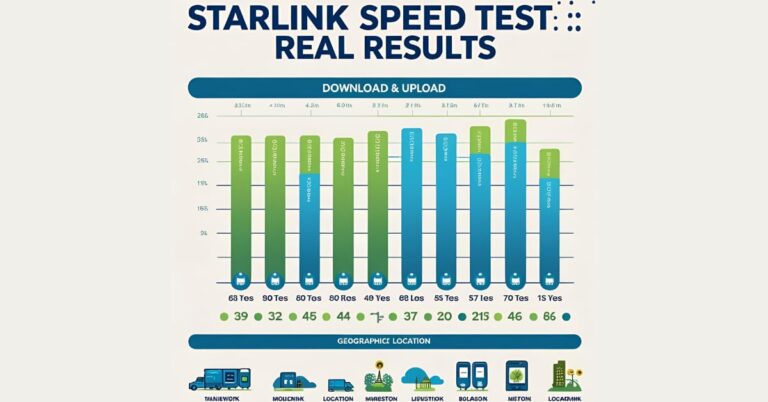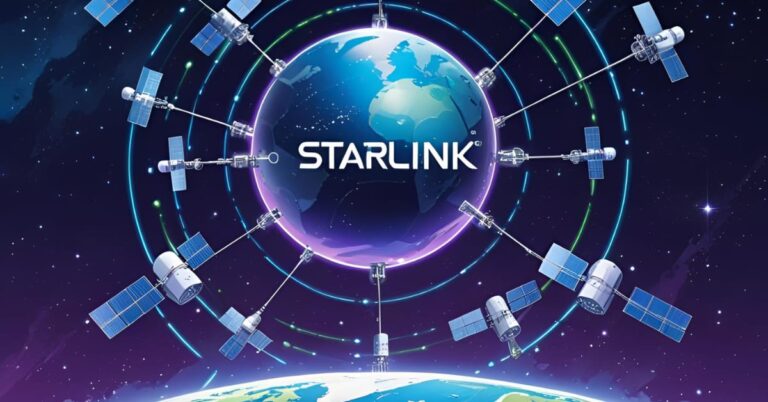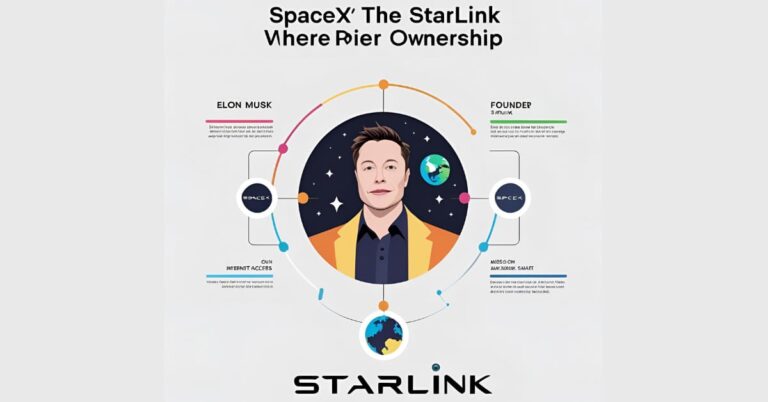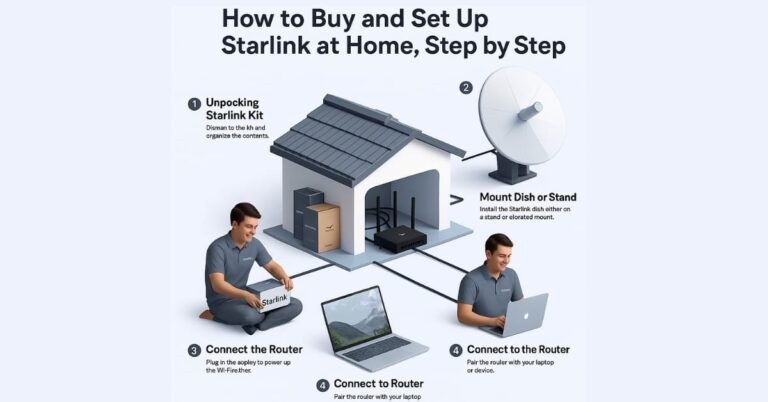Starlink Internet Plans Explained: Residential, RV, Roam
In the modern world, reliable, high-speed internet is no longer a luxury but a necessity. Yet, this necessity remains a distant dream for millions living in rural, remote, or underserved areas. Traditional internet systems, like fibre optics and cable, don’t reach remote regions well, creating a significant “digital divide”.
Enter Starlink, the revolutionary satellite internet service from SpaceX, led by Elon Musk. Starlink plans to use thousands of satellites in Low Earth Orbit (LEO), providing high-speed, low-latency internet to nearly every part of the world. This blog post will detail each Starlink plan, compare their key differences, and help you find the best fit for your needs.
How Starlink Works: A Quick Overview
Before we dive into the plans, it’s essential to understand the technology. Starlink’s satellites are much closer to Earth, orbiting only a few hundred kilometres up. This is not like traditional satellite internet. That type uses a few big satellites in geostationary orbit, over 35,000 km away. This closeness significantly cuts down the “ping” or latency. That’s the time needed for data to move from your dish to the satellite and back.
The user equipment, called the “Starlink Kit,” includes a satellite dish, nicknamed “Dishy,” a mounting base, and a Wi-Fi router. The dish automatically adjusts to connect with orbiting satellites, creating a fast and reliable link. This new method lets Starlink provide speeds and latency similar to regular broadband. It works well, even in far-off places.
A Detailed Look at the Starlink Plan Ecosystem
As of mid-2025, Starlink has refined its offerings to serve different user types better. You read a detailed breakdown of the main plans:
1. The Residential Plan: The Flagship for Fixed Locations
This is Starlink’s most popular and widely used plan, designed specifically for home and office use at a single, fixed address.
Primary Use Case: The ideal choice for families, remote workers, gamers, and streamers who need a dependable, high-performance connection at a permanent location.
Key Features & Performance (2025 data):
Network Priority:
Residential users receive the highest network priority during times of congestion. This means that your connection gets priority even during busy hours, like in the evenings. It’s better than mobile connections and those that are deprioritised. This keeps speeds stable and reduces delays for essential tasks like video calls and gaming.
Unlimited Standard Data:
The Residential plan comes with truly unlimited data. You won’t face data caps or throttling, so you can stream, download, and browse freely without worrying about limits.
Typical Speeds
In June 2025, residential users experienced average download speeds of 50 Mbps to 250 Mbps. Their upload speeds ranged from 10 Mbps to 25 Mbps. These speeds easily handled 4K streaming on multiple devices. They also supported online gaming and large file transfers.
Availability:
Starlink’s coverage is now global. Some areas still have a waitlist, especially for popular “cells.” When you order, you’ll find out if the service is ready or if you need to wait in line.
Pricing (as of June 2025):
- Hardware Cost: The Starlink Kit costs $349 to $599, which varies by region and current promotions.
- Monthly Subscription: The monthly service fee is typically between $90 and $120. Due to taxes and exchange rates, this price can vary slightly by country.
Best for:
- Homes in rural areas without other broadband options
- Cottages
- Remote cabins
- Small fixed businesses
If your life is centred around a single location, this is the plan for you.
2. The Roam/Mobile Plan: The Traveller’s Companion
This plan follows the original “Starlink RV” plan. It’s now called “Roam” or “Mobile.” It’s designed for users who need internet on the move.
Primary Use Case: This is great for RV owners, digital nomads, campers, and anyone who travels a lot. It provides reliable internet, no matter where you are.
Key Features & Performance (2025 data):
- This plan’s defining feature is its portability. You can take your Starlink dish with you and use it at any location with active Starlink coverage. The hardware is designed for easy setup and teardown.
- Deprioritised Data: This is a crucial distinction. Roam/Mobile users receive “deprioritised” data. Your connection speeds might slow down during busy times or in crowded places. This helps keep a steady experience for residential users. This is a trade-off for the flexibility of portability.
- Typical Speeds: Speeds can be less consistent due to deprioritization. You can expect download speeds to range from 5 Mbps to 100 Mbps, with upload speeds from 2 Mbps to 10 Mbps. Performance is highly dependent on network traffic at your current location.
- Coverage Options:
- Regional: Allows you to use the service within your home country or continent.
- Global: Provides connectivity in all countries where Starlink is available. This is ideal for international travellers.
- Hardware: The standard dish works well. However, Starlink now offers the smaller, portable Starlink Mini for Roam users. It uses less power, too.
Pricing (as of June 2025):
- Hardware Cost: The standard kit typically costs around $599. The newer Starlink Mini, priced at $599, is a game-changer for portability.
- Monthly Subscription: The monthly fee is higher than the Residential plan. It usually ranges from $150 to $200 for the Regional plan and is higher for the Global option. Some plans may include a soft data cap (e.g., 50GB of standard data per month), after which speeds may be further reduced.
Best for: Anyone living a nomadic lifestyle or needing internet for their RV, boat, or camper van while travelling.
3. The Mobile Priority Plan: The Ultimate for High-Demand Users
This is Starlink’s top plan for businesses. It’s designed for critical applications and users who need reliable performance.
Primary Use Case:
- Businesses
- Maritime vessels (yachts, cargo ships)
- Aviation
- Emergency services
- High-demand remote operations where connectivity is crucial.
Key Features & Performance (2025 data):
- High-Priority Data: Unlike the deprioritised Roam plan, Mobile Priority users get top-tier network priority. This guarantees the best speeds and reliability, even in crowded areas.
- In-Motion Use: This plan offers high-performance hardware for connectivity on the go. It’s perfect for vehicles, trains, and planes.
- Public IP: Provides a public IP address. This is key for businesses that host servers or need specific networking protocols.
- High-Speed Data Buckets: This plan operates on a tiered data model. Users buy high-priority data (e.g., 50GB, 1TB, 5TB) monthly. Once this data is consumed, the service slows down or incurs overage charges.
- Typical Speeds: Speeds are fast and reliable, usually between 40 Mbps and 220 Mbps. They have low latency, especially with priority data.
Pricing (as of June 2025):
- Hardware Cost: The high-performance hardware needed for this plan is costly. It usually costs between $1,499 and over $2,500.
- Monthly Subscription: The cost starts at $250 for lower data tiers and grows with your need for priority data, reaching thousands for larger amounts.
Best for:
- Commercial operations
- Luxury yachts
- Research vessels
- Any application where internet reliability is a must.
Ranking Keyword: Starlink Mobile Priority, Starlink Business.
Head-to-Head Comparison: Finding Your Perfect Plan. Here’s a quick comparison table to help you decide:
Feature
Residential Plan
Roam / Mobile Plan
Mobile Priority Plan
Ideal User
Home, fixed location
Traveller, RV owner, nomad
Business, Maritime, Aviation
Network Priority
High Priority (Top tier)
Deprioritised (lower priority)
Highest Priority (Guaranteed performance)
Download Speed (Avg.)
50 – 250 Mbps
5 – 100 Mbps (Variable)
40 – 220 Mbps (consistent)
Monthly Cost
$90 – $120
$50 – $165 (Regional/Global)
$250 – $5,000+ (Tiered data)
Hardware Cost
$349 – $599
$599
$1,499 – $2,500+
Portability
No (Fixed)
Yes (land-based travel)
Yes (Land, sea, air)
Data
Unlimited Standard
Deprioritized Standard
Priority Data
Important Considerations Before You Buy
- Obstructions Matter: The Starlink dish needs a clear sky view to work well. Trees, buildings, or other structures can block the signal and cause outages. Use the Starlink app to check for possible obstructions at your installation site.
- No Contracts: Starlink’s significant advantage is that all its services are month-to-month. There are no long-term contracts, and you can pause or cancel your service anytime.
- Weather: Starlink can handle tough weather, but heavy rain or snow can temporarily decrease its performance.
- The Starlink Kit: The self-installation process is straightforward and intuitive. The kit has everything you need to start, and the app guides you through the setup.
A Special Note for Pakistan: Starlink’s Anticipated Launch (2025)
For our readers in Pakistan, the prospect of Starlink’s official launch is a hot topic. By June 2025, the Pakistan Telecommunication Authority (PTA) will have almost finished its regulatory approvals. A full commercial launch should happen by late 2025.
What you can expect:
- Expected Pricing: Official prices aren’t out yet. The estimated cost for the Starlink hardware kit is about PKR 110,000 to PKR 150,000, based on global prices and local market trends. The monthly fee for the Starlink Residential plan is expected to be between PKR 35,000 and PKR 45,000. These figures are subject to change but provide a realistic estimate.
- A Game-Changer: Starlink will transform internet access in Pakistan. Remote areas like Balochistan, Gilgit-Baltistan, and Sindh need this most, as they lack traditional broadband.
- Pre-Orders: Check the official Starlink website for pre-order updates in your area. Demand will be very high.
Conclusion: Choose the plan that fits your life.
Starlink has changed the lives of millions. It offers high-speed internet in places where it was once unthinkable. Understanding each Starlink internet plan helps you pick the best one for your needs and lifestyle.
- Choose Residential if you have a fixed address. This option gives you reliable, high-priority internet at home.
- Choose Roam / Mobile if you’re a traveller, a digital nomad, or an RVer who needs flexible connectivity.
- Select Mobile Priority if you run a business or work in a fast-paced setting. Reliable speeds and consistency are crucial here.
The future of internet connectivity is here, and with Starlink, you’re not just getting a service; you’re gaining access to a world of possibilities, no matter where you find yourself on the map.
